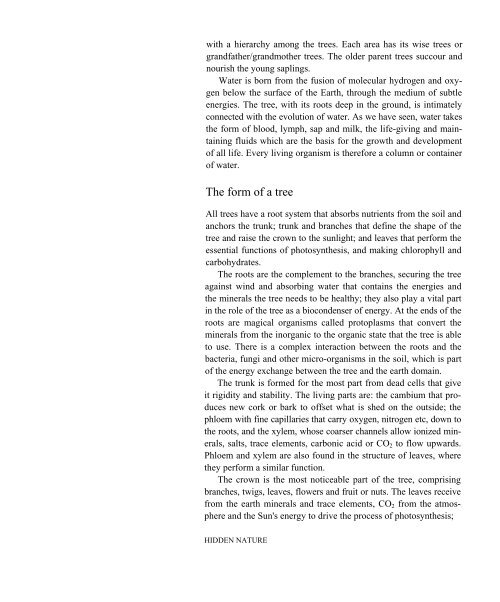levitational current - Free Energy
levitational current - Free Energy
levitational current - Free Energy
Create successful ePaper yourself
Turn your PDF publications into a flip-book with our unique Google optimized e-Paper software.
with a hierarchy among the trees. Each area has its wise trees or<br />
grandfather/grandmother trees. The older parent trees succour and<br />
nourish the young saplings.<br />
Water is born from the fusion of molecular hydrogen and oxygen<br />
below the surface of the Earth, through the medium of subtle<br />
energies. The tree, with its roots deep in the ground, is intimately<br />
connected with the evolution of water. As we have seen, water takes<br />
the form of blood, lymph, sap and milk, the life-giving and maintaining<br />
fluids which are the basis for the growth and development<br />
of all life. Every living organism is therefore a column or container<br />
of water.<br />
The form of a tree<br />
All trees have a root system that absorbs nutrients from the soil and<br />
anchors the trunk; trunk and branches that define the shape of the<br />
tree and raise the crown to the sunlight; and leaves that perform the<br />
essential functions of photosynthesis, and making chlorophyll and<br />
carbohydrates.<br />
The roots are the complement to the branches, securing the tree<br />
against wind and absorbing water that contains the energies and<br />
the minerals the tree needs to be healthy; they also play a vital part<br />
in the role of the tree as a biocondenser of energy. At the ends of the<br />
roots are magical organisms called protoplasms that convert the<br />
minerals from the inorganic to the organic state that the tree is able<br />
to use. There is a complex interaction between the roots and the<br />
bacteria, fungi and other micro-organisms in the soil, which is part<br />
of the energy exchange between the tree and the earth domain.<br />
The trunk is formed for the most part from dead cells that give<br />
it rigidity and stability. The living parts are: the cambium that produces<br />
new cork or bark to offset what is shed on the outside; the<br />
phloem with fine capillaries that carry oxygen, nitrogen etc, down to<br />
the roots, and the xylem, whose coarser channels allow ionized minerals,<br />
salts, trace elements, carbonic acid or CO 2 to flow upwards.<br />
Phloem and xylem are also found in the structure of leaves, where<br />
they perform a similar function.<br />
The crown is the most noticeable part of the tree, comprising<br />
branches, twigs, leaves, flowers and fruit or nuts. The leaves receive<br />
from the earth minerals and trace elements, CO 2 from the atmosphere<br />
and the Sun's energy to drive the process of photosynthesis;<br />
HIDDEN NATURE








![The Big Lie 9-11 and Government Complicity in Mass Murder [PDF]](https://img.yumpu.com/50957077/1/190x245/the-big-lie-9-11-and-government-complicity-in-mass-murder-pdf.jpg?quality=85)








